Oroantral Fistula Closure Surgery – Dr SM Balaji, Oral and Maxillofacial Surgeon, India
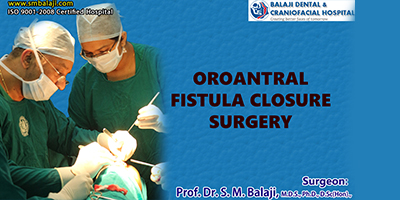
This patient developed an oroantral fistula after undergoing a traumatic extraction of the right maxillary second molar a few years ago in his hometown. He had already been operated a few times previously, but the fistula kept recurring. An oroantral fistula is a communication between the oral cavity and the maxillary sinus that is lined by epithelial tissue. He was referred to Balaji Dental and Craniofacial Hospital, Teynampet, Chennai for management of his problem. Oroantral Fistula Closure Surgery Dr. S. M. Balaji examined the patient and decided to perform a palatal flap closure of his oroantral fistula. Following successful induction of general anesthesia, a palatal flap was raised, the epithelialized tissue from the fistula was excised and closure was obtained by suturing the flap over the oroantral fistula. The patient presented to Dr. Balaji a month after surgery and a nose blow test confirmed complete closure of his fistula. The patient expressed his gratitude to Dr. Balaji for solving this long standing problem, which was causing significant mental anguish for the patient.
Pleomorphic Adenoma of the Palate Excision – Dr. S.M Balaji
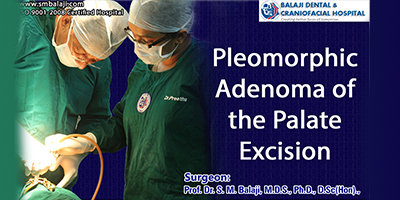
This 20 year old girl reported to our hospital with the complaint of a swelling on the left side of the palate for the past 12 years. The swelling was gradually increasing in size and it became more noticeable about two years ago. Of late, she has been having difficulty swallowing food. After thorough clinical and radiological analysis, Dr. S. M. Balaji, Maxillo-Craniofacial Surgeon provisionally diagnosed it to be a pleomorphic adenoma. Differential diagnoses for this included palatal abscesses, soft tissue tumors such as fibroma, lipoma, neurofibroma, and neurilemmoma as well as other salivary gland tumors. Pleomorphic adenoma is a benign neoplasm, which is commonly encountered in the parotid gland and other major salivary glands. Infrequently, it may arise from minor salivary glands and present as an intraoral mass over the palate or lip. Salivary gland tumors are rare and account for 2–3% of tumors occurring in the head and neck. On examination, an oval-shaped, well-circumscribed lesion that was adherent to the underlying structures was seen on the left side of the hard palate. The lesion was about 2 cm in diameter. The swelling extended from the mid-palatal area to the border of the alveolar ridge on the left side. The overlying mucosa was smooth and intact, but was stretched and shiny in comparison to the healthy area on the opposite side of the palate. There was no regional lymphadenopathy and her general physical and systemic examination was normal except for a minor thyroid hormone imbalance with TSH being elevated. With the help of 3-D axial CT scan, extension of the lesion was traced. Superiorly, it extended to the floor of the nasal cavity and its posterior extension was up to a cm anterior to the greater palatine foramen. The lesion had eroded the underlying palatal bone and was well circumscribed with clear margins. Excisional biopsy was done. Under general anesthesia, a palatal crevicular incision was made and a palatal mucosal flap was raised along with the underlying mucoperiosteum, thus exposing the lesion. The soft tissue mass was removed in toto with good clearance and it was well encapsulated and soft fibrous in texture. Following this, the palatal mucosal flap was approximated and sutured in position and the tissue obtained was sent for histopathological examination. Histopathology revealed it to be a pleomorphic adenoma of the palate. The palatal bone defect caused by erosion due to the tumor was planned to be reconstructed at a later date using auto bone graft.
Blowout Fracture – Zygomatic Orbital Complex Surgery with Open Reduction and Fixation of Zygomatic Complex
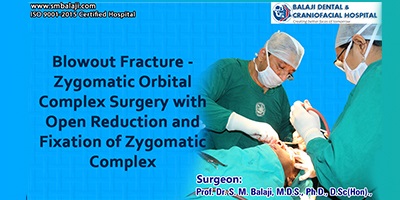
This middle aged man met with a road traffic accident with impact to the left side of his face. He had severe pain and swelling on the left side of his face and was rushed to Balaji Dental and Craniofacial Hospital, Teynampet, Chennai by his family after first aid had been administered elsewhere. Dr. S. M. Balaji examined the patient and ordered a CT scan, which showed a comminuted fracture of his left cheekbone (zygoma) and fracture of the floor of the left orbital bone. The patient was taken to the operating room and the fracture of the zygomatic complex was approached through a vestibular incision placed in the maxillary buccal sulcus on the left side. A flap was raised and the fracture fragments were carefully stabilized and fixed using plates and screws. The fracture of the floor of the left orbit was next accessed through a transconjunctival approach. The herniated fat and orbital contents were elevated and the titanium mesh that had been adapted to the contours of the floor of the orbit was placed over the fracture site to stabilize it. The mesh was then anchored to the orbital margin using screws. The surgical sites were then closed with sutures. The patient recovered from general anesthesia without complications and was taken to his room in stable condition. Surgery Video
Lip Reduction Surgery – Dr. S.M Balaji, Balaji Dental and Craniofacial Hospital
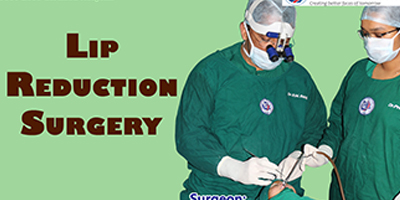
Lip Reduction Surgery The patient presented at Balaji Dental and Craniofacial Hospital, Teynampet, Chennai, with the complaint of an excessively large lower lip. She said that she wanted it to be reduced to be proportionate to the upper lip. Dr. S. M. Balaji, Maxillo-Craniofacial Surgeon, examined the patient and explained the surgical correction procedure in detail. The patient consented and was scheduled for surgery. Under general anesthesia, the portion of the lip that was to be excised was marked out carefully. Incision was then made along the markings and extended down into the submucosal region. Dissection was carried down into the deeper tissues and excess tissue was excised from the region. Once adequate removal of excess tissue was performed, the vermillion borders of the incision were approximated with sutures. At the two week postoperative visit to the hospital, the patient expressed her satisfaction at the results of the surgery. Surgery Video
Fibrous dysplasia reduction Osteotomy
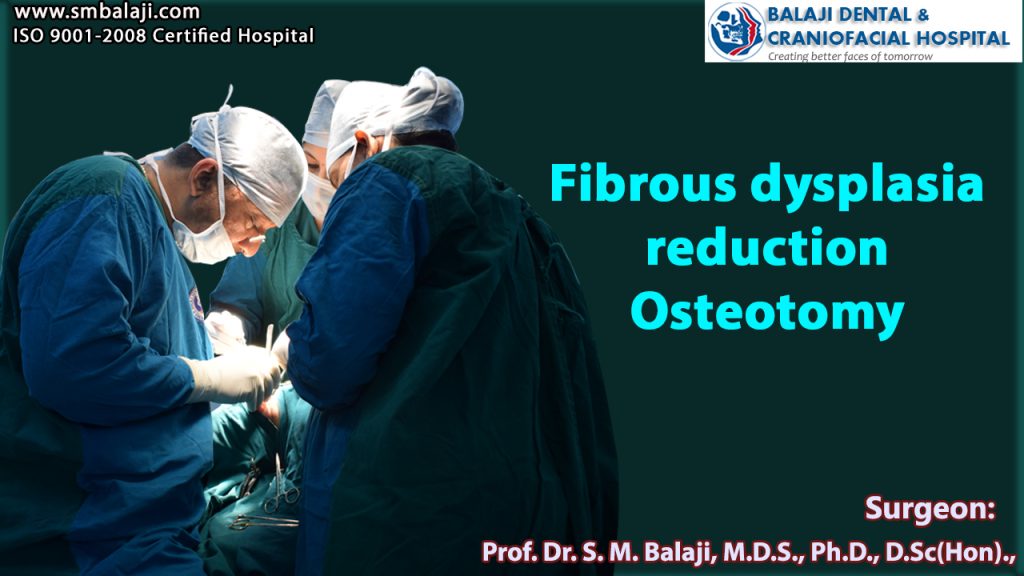
This lady had been aware for some time now that the left side of her lower jaw was slowly, but surely increasing in size. Since the lesion was painless, she had ignored it for a while. Her family decided that she needed medical intervention and took her to a dentist in their hometown. She was referred by that dentist to Balaji Dental and Craniofacial Hospital, Teynampet, Chennai, for management of her problem. Dr. S. M. Balaji, Maxillo-Craniofacial Surgeon, examined the patient and ordered a 3D axial CT scan, which revealed a dense overgrowth in the region, which is characteristic of fibrous dysplasia. This is a disorder of the bone where normal bone is replaced by a scar-like fibrous tissue that leads to weakening of the bone structure. Dr. Balaji explained to the patient and her family that a reduction osteotomy was necessary to restore symmetry to the patient’s face. They were in agreement with this and she was scheduled for surgery. Under satisfactory general anesthesia, a mucogingival flap was raised distal to the left lower canine and extended to the vestibule to expose the entire fibrous dysplasia lesion. The fibrous bone was then trimmed with high speed drills until perfect facial asymmetry was reestablished. Care was taken to ensure that the mental nerve was protected throughout the surgery. The flaps were then closed with sutures and the patient recovered uneventfully from general anesthesia. The patient expressed her deep gratitude to Dr. Balaji for restoring symmetry back to her face before being discharged from the hospital.
Paediatric (Child) Rhinoplasty Surgery with Costal Cartilage
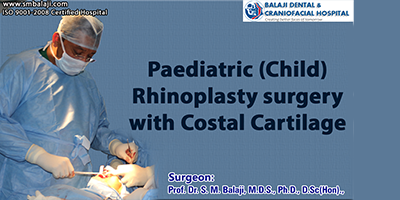
The patient had a collapsed tip of nose at birth. This particular defect would under normal circumstances be repaired only at a much later stage, but this particular child was being picked on and mocked constantly at school by other children. This distressed the child to a degree that it was affecting her emotional and psychological health. The parents of the child were distressed upon seeing this and approached Dr. S. M. Balaji, Craniofacial Surgeon, Chennai, who upon hearing about the child’s plight decided to perform the surgery on humanitarian grounds. A costal cartilage graft was first harvested from the right rib cage and the wound was subsequently closed in layers. Following this, the costal cartilage was molded and shaped for graft placement to augment the tip of the nose. The costal cartilage graft was tunneled along the base of the nasal septum until it approximated the collapsed tip of the nose. Once normal nasal tip anatomy had been reestablished by proper positioning of the graft and normal profile of the nose had been regained, the graft was sutured in place. Following this, the intraoral incision was sutured and closed. Secondary corrections might be needed at a later stage. The patient and her parents were extremely pleased with the aesthetic results of the surgery.
Periapical Cyst Enucleation and Filling with Alloplastic Material
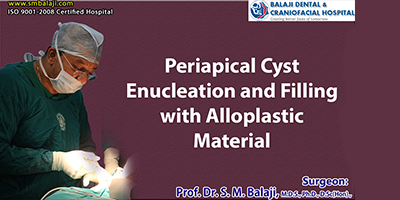
This young man presented to Balaji Dental and Craniofacial Hospital with a painful right lateral incisor associated with a swelling on the right side of his hard palate. Dr. S. M. Balaji, Cranio-Maxillofacial Surgeon examined the patient and ordered an OPG, which revealed a periapical cyst in relation to that tooth. He explained to the patient that the cyst had to be removed and the resultant bony defect filled with a bone graft material. After uneventful induction of general anesthesia, a gingival flap was raised in the region of the anterior maxilla and pus was drained from the periapical cyst. Next, the cyst was removed from the cavity in the bone. Bone was then removed with a round bur to gain better access into the cavity and the cavity was filled with Bio-Oss, an alloplastic bone graft material. The flap was then sutured back in place and the patient recovered uneventfully from general anesthesia.
Primary lip repair for unilateral cleft lip and palate
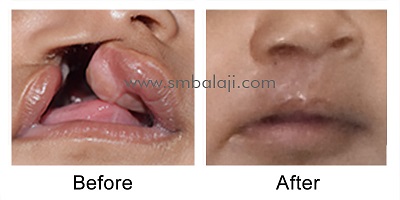
[vu_heading style=”1″ heading=”Unilateral Cleft Lip Repair” alignment=”left” custom_colors=”” class=””] A 3-month old baby girl born with wide unilateral cleft lip & palate was brought to our hospital by her parents seeking the best treatment for cleft lip and palate. The parents were greatly perturbed by their baby girl’s condition. Maxillofacial Surgeon Dr. S.M. Balaji performed the primary unilateral cleft lip repair surgery using Modified Millard’s technique. Following surgery, the baby appearance improved greatly and looked like any other baby of her age with minimal to no scar. The parents were overjoyed with the results. Consecutively cleft palate correction surgery will be done at a later date.
Successful removal of sizable odontogenic keratocyst and reconstruction of lower jaw
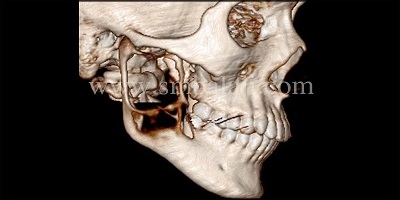
A 13 year old girl from Manipur was brought to our hospital by her parents seeking the best treatment for facial asymmetry. The girl initially presented with a complaint of huge swelling in the right side of the face which was increasing in size. The parents were greatly worried about their daughter’s present condition. Through clinical and radiological investigations revealed a large radiolucent lesion involving the entire ramus and angle of the mandible extending to the lateral side of lower right first molar teeth. Biopsy of the lesion confirmed the lesion to be odontogenic keratocyst. The parents were explained that the facial asymmetry was only due to the cystic contents. Maxillofacial Surgeon Dr.S.M.Balaji planned to do segmental mandibulectomy followed by reconstruction with rib graft. Dr.S.M.Balaji successfully removed the cyst completely along with the affected bone and teeth. Rib graft was harvested and used to reconstruct the jaw bone defect and the surgical site was closed. After subsequent healing, implants & ceramic crowns will be placed for permanent replacement of lost teeth.
Successful correction of long and deviated lower jaw – facial asymmetry without any scars
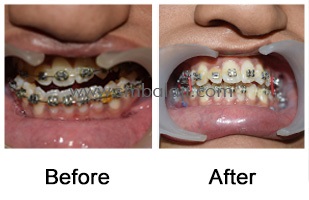
A 23-year-old girl reported to our hospital seeking to correct her protruding and deviated lower jaw. She was discontent with her facial appearance and mentioned about her inability to chew food. After thorough clinical and radiological examination, Maxillofacial Surgeon Dr. S. M. Balaji planned to correct her bite both orthodontically and surgically. Presurgical orthodontic treatment was started and the teeth were aligned. Through intraoral approach, bilateral sagittal split osteotomy (Obwegesers and short lingual split technique) was done and the excessive length of the mandible was reduced. The patient was beaming with joy on seeing the results as there was no visible post-surgical scar. Her speech and ability to chew food also improved markedly.
